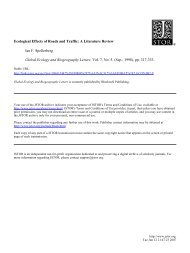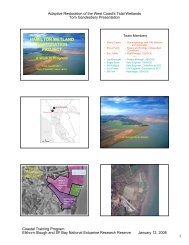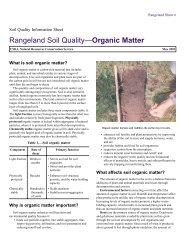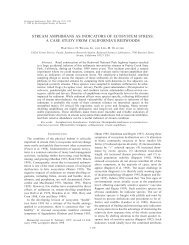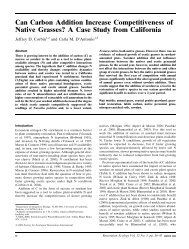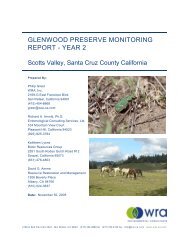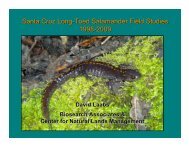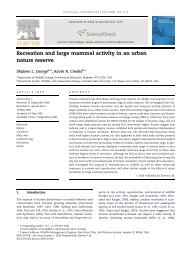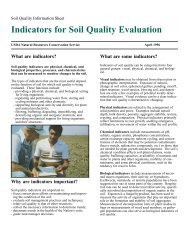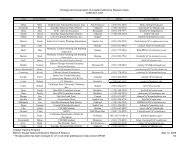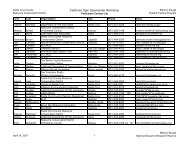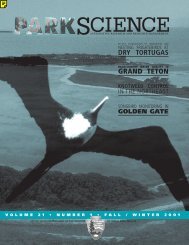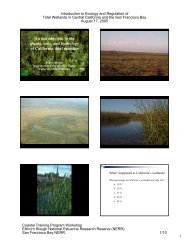<strong>BIRD</strong> <strong>POPULATIONS</strong>A journal of global avian demography and biogeographyVolume 10 2010 (2009-2010)REPORTS OF AVIAN MONIOTORING PROGRAMSINTRODUCTION TO THE REPORTSStandardized broad-scale bird-bandingprograms (or bird-ringing programs as they areknown in Europe and elsewhere in the easternhemisphere) are an important component ofnational and international integrated avianmonitoring efforts. Such programs include theMonitoring Avian Productivity and Survivorship(MAPS) program in North America andthe Constant Effort Sites (CES) schemes inBritain and a number of other Europeancountries, and provide critical information onpost-fledging productivity and annual apparentadult survival rates. Despite the rich spatialstructure of the data provided by theseprograms and widespread interest in understandingspatial patterns of populationprocesses, little attention had been paid tospatial modeling of demographic rates. Recently,however, researchers at The Institute for BirdPopulations and the USGS Patuxent WildlifeResearch Center implemented Bayesianhierarchical analyses of a spatial autoregressivemodel based on the transient Cormack-Jolly-Seber (CJS) capture-recapture model to providespatially explicit and year-specific survival andresidency probabilities for Wood Thrush(Saracco et al. 2010. Ecology 91:1885-1891) andCommon Yellowthroat (Saracco et al. 2010. J.Ornithology, Online First, 10 August) from 12years (1992-2003) of MAPS data.Most previous studies that applied transientCJS models to capture-recapture data had largelybeen concerned with reducing the negative biasof transient individuals on survival estimates.Little attention had been paid to spatial ortemporal modeling of residency probabilityitself. The clear spatial patterns in residencyprobability revealed by these recent studies,however, suggest that the residency parameterhas important ecological relevance. Indeed, forboth Wood Thrush and Common Yellowthroat,these recent spatial autoregressive modelsshowed that spatial variation in survival andresidency tended to be independent of eachother. Areas where survival probability was highand residency probability was low could suggesta combination of good non-breeding seasonconditions and breeding habitat limitation. Incontrast, areas with low survival and highresidency could suggest areas where individualsexperienced low survival due to poor nonbreedingseason conditions, with subsequentample opportunity for new territory establishment(and thus few floaters).Clearly, the spatial modeling of avian survivaland residency probabilities, and of productivityand recruitment rates, especially in relationshipto climate, weather, and habitat, can providevaluable data useful for informing conservationand management. Such data can provide insightsinto causes of avian population trends, can helpidentify areas where problems are acute andareas where they will be further exacerbated byclimate change, can lead both to managementstrategies for reversing population declines andto adaptation strategies for climate change, andcan provide a means for evaluating the effectivenessof conservation, management, and adaptationstrategies. This will only happen, however,with continued spatially-extensive avianpopulation and demographic monitoring, which,in turn, will require long-term commitments of[88]
DAVID F. DESANTEhuman and financial resources. Obtaining suchcommitments in these difficult times depends inno small part upon the timely production andwidespread dissemination of results from theseavian demographic monitoring programs.Just as during the 1980s and 1990s, whenresearchers at the British Trust for Ornithologyprovided leadership in the development andimplementation of integrated avian populationmonitoring, they have more recently providedleadership in disseminating the results of thatmonitoring. Moreover, the manner they haveimplemented for disseminating their results hasprovided land managers and stewards,including those from both public and privatesectors, with information for identifying avianspecies and populations at risk, as well asinformation and direction for managing andconserving not only those at-risk populations butpopulations of common species as well. Theheart of the BTO’s effort at disseminating theresults of integrated population monitoring is itsannual Breeding Birds in the Wider Countryside:Their Conservation Status report, a web-basedcompendium of trends, from 1966 to the present,in numbers and breeding performance for 115species breeding in the UK. Each species has itsown “page” in this report on which is providedits conservation listing, its status summary, and,in graphical and tabular formats, its populationand demographic trends, including laying date,clutch and brood sizes, egg and chick nest failurerates, fledglings per breeding attempt, and CESproductivity indices and adult apparent survivalrates. Links are also provided for each species toother monitoring results and resources,including the British and Irish Bird Atlases andBirdtrack and Garden BirdWatch results.We are very pleased, therefore, to announcethat, beginning with Volume 10, Bird Populationswill be publishing links to the annual BTOBreeding Birds in the Wider Countryside reports. Inaddition, beginning with Volume 10, we will alsoinclude links to the annual reports of the BritishBreeding Bird Survey (BBS), Wetland BirdSurvey (WeBS), and Constant Effort Sites (CES)scheme, the last as presented in the BTO’s CESNews. We believe that by providing direct accessto these reports on the BTO’s website, rather thanby providing reprints of reports of theseprograms from the BTO News, we will allowreaders of Bird Populations to gain better access toincreasingly detailed information and resultsfrom these important monitoring programs.Volume 10 will continue to provide reprints fromBTO News of the annual reports of the NestRecord Scheme and Garden Bird Feeding Survey,for which there are no comparable electronicreports to which we can link.We hope that by publishing, reprinting, andproviding links in Bird Populations to reports ofmajor avian monitoring programs, we will drawattention in a timely manner to short-term avianpopulation fluctuations that may ultimatelyprove to be geographically widespread or thatmay signal the beginnings of longer-term trends.We hope further that by disseminating thesereports we will help provide a global informationalnetwork for addressing avian populationchanges, will encourage an integrativeglobal approach to avian monitoring studies, willstimulate the establishment of additional avianmonitoring programs, and ultimately will aid inthe conservation of global avian diversity. –David F. DeSante.[89]
- Page 1 and 2:
BIRD POPULATIONSA journal of global
- Page 3 and 4:
BIRD POPULATIONSA journal of global
- Page 6 and 7:
ROBERT L. WILKERSON AND RODNEY B. S
- Page 8 and 9:
ROBERT L. WILKERSON AND RODNEY B. S
- Page 10 and 11:
ROBERT L. WILKERSON AND RODNEY B. S
- Page 12 and 13:
ROBERT L. WILKERSON AND RODNEY B. S
- Page 14 and 15:
ROBERT L. WILKERSON AND RODNEY B. S
- Page 16 and 17:
ROBERT L. WILKERSON AND RODNEY B. S
- Page 18 and 19:
ROBERT L. WILKERSON AND RODNEY B. S
- Page 20 and 21:
ROBERT L. WILKERSON AND RODNEY B. S
- Page 22 and 23:
ROBERT L. WILKERSON AND RODNEY B. S
- Page 24 and 25:
ROBERT L. WILKERSON AND RODNEY B. S
- Page 26 and 27:
ROBERT L. WILKERSON AND RODNEY B. S
- Page 28 and 29:
ROBERT L. WILKERSON AND RODNEY B. S
- Page 30 and 31:
ROBERT L. WILKERSON AND RODNEY B. S
- Page 32 and 33:
ROBERT L. WILKERSON AND RODNEY B. S
- Page 34 and 35:
ROBERT L. WILKERSON AND RODNEY B. S
- Page 36 and 37:
ROBERT L. WILKERSON AND RODNEY B. S
- Page 38 and 39:
ROBERT L. WILKERSON AND RODNEY B. S
- Page 40 and 41: NIRANJAN DAS AND SUJATA DEORIincluy
- Page 42 and 43: NIRANJAN DAS AND SUJATA DEORIprovid
- Page 44 and 45: NIRANJAN DAS AND SUJATA DEORIpopula
- Page 46 and 47: NIRANJAN DAS AND SUJATA DEORITABLE
- Page 48 and 49: NIRANJAN DAS AND SUJATA DEORITABLE
- Page 50 and 51: NIRANJAN DAS AND SUJATA DEORITABLE
- Page 52 and 53: NIRANJAN DAS AND SUJATA DEORITABLE
- Page 54 and 55: NIRANJAN DAS AND SUJATA DEORITABLE
- Page 56 and 57: NIRANJAN DAS AND SUJATA DEORITABLE
- Page 58 and 59: Bird Populations 10:56-64© The Ins
- Page 60 and 61: WETLAND BIRDS OF GHANAAvicennia afr
- Page 62 and 63: WETLAND BIRDS OF GHANATABLE 1. Data
- Page 64 and 65: WETLAND BIRDS OF GHANATABLE 2: Esti
- Page 66 and 67: WETLAND BIRDS OF GHANAATTUQUAYEFIO,
- Page 68 and 69: JANNIK HANSEN, LARS HOLST HANSEN, N
- Page 70 and 71: JANNIK HANSEN, LARS HOLST HANSEN, N
- Page 72 and 73: JANNIK HANSEN, LARS HOLST HANSEN, N
- Page 74 and 75: JANNIK HANSEN, LARS HOLST HANSEN, N
- Page 76 and 77: JANNIK HANSEN, LARS HOLST HANSEN, N
- Page 78 and 79: JANNIK HANSEN, LARS HOLST HANSEN, N
- Page 80 and 81: JANNIK HANSEN, LARS HOLST HANSEN, N
- Page 82 and 83: JANNIK HANSEN, LARS HOLST HANSEN, N
- Page 84 and 85: JANNIK HANSEN, LARS HOLST HANSEN, N
- Page 86 and 87: JANNIK HANSEN, LARS HOLST HANSEN, N
- Page 88 and 89: JANNIK HANSEN, LARS HOLST HANSEN, N
- Page 92 and 93: Bird Populations 10:90-109© The In
- Page 94 and 95: DAVID J. ZIOLKOWSKI JR., KEITH L. P
- Page 96 and 97: DAVID J. ZIOLKOWSKI JR., KEITH L. P
- Page 98 and 99: DAVID J. ZIOLKOWSKI JR., KEITH L. P
- Page 100 and 101: DAVID J. ZIOLKOWSKI JR., KEITH L. P
- Page 102 and 103: DAVID J. ZIOLKOWSKI JR., KEITH L. P
- Page 104 and 105: DAVID J. ZIOLKOWSKI JR., KEITH L. P
- Page 106 and 107: DAVID J. ZIOLKOWSKI JR., KEITH L. P
- Page 108 and 109: DAVID J. ZIOLKOWSKI JR., KEITH L. P
- Page 110 and 111: DAVID J. ZIOLKOWSKI JR., KEITH L. P
- Page 112 and 113: Bird Populations 10:110-113© The I
- Page 114 and 115: THE 2007 AND 2008 NORTH AMERICAN BR
- Page 116 and 117: Bird Populations 10:114-124© The I
- Page 118 and 119: BREEDING BIRD CENSUS: 2007on the pl
- Page 120 and 121: BREEDING BIRD CENSUS: 2007May, with
- Page 122 and 123: BREEDING BIRD CENSUS: 2007Remarks:
- Page 124 and 125: BREEDING BIRD CENSUS: 200717. PITCH
- Page 126 and 127: BREEDING BIRD CENSUS: 2007+; Wester
- Page 128 and 129: BREEDING BIRD CENSUS: 2008gray Gnat
- Page 130 and 131: BREEDING BIRD CENSUS: 2008Warbler,
- Page 132 and 133: BREEDING BIRD CENSUS: 2008Source: W
- Page 134 and 135: BREEDING BIRD CENSUS: 2008Spotted T
- Page 136 and 137: BREEDING BIRD CENSUS: 2008precipita
- Page 138 and 139: Bird Populations 10© The Institute
- Page 140 and 141:
IS AVIAN BREEDING SUCCESS WEATHERIN
- Page 142 and 143:
IS AVIAN BREEDING SUCCESS WEATHERIN
- Page 144 and 145:
DAVE LEECH AND CARL BARIMOREFlycatc
- Page 146 and 147:
Bird Populations 10:143-145Reprinte
- Page 148 and 149:
WOODPIGEON JOINS THE GARDEN PREMIER
- Page 150 and 151:
CHANGING THE GUARD AT UK BIRDTABLES
- Page 152 and 153:
Bird Populations is an entirely ele
- Page 154:
BIRD POPULATIONSA journal of global



